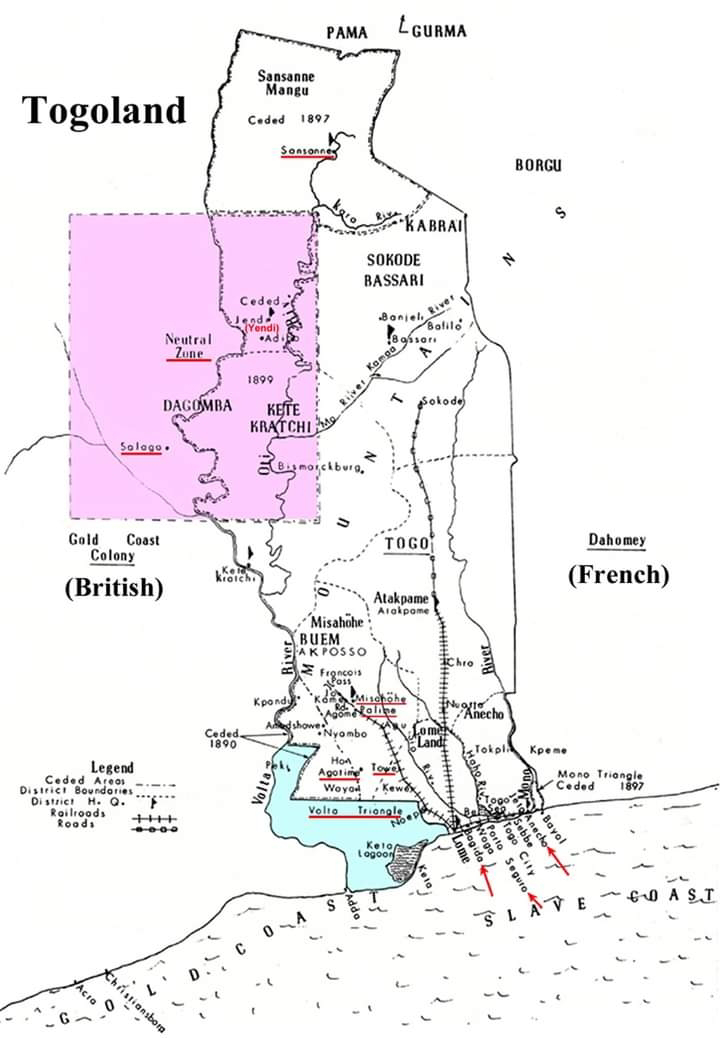THE VOLTA TRIANGLE AND THE EWE-GERMAN RELATIONSHIP
The #Volta_Triangle is a designated name given to a mapped out area within the original “German Togoland” which was a Protectorate of Germany from 1883 to 1914.
This areas specifically include ANLO, TONGU and PEKI and some other areas within the current Volta Region of Ghana.
WHATS A PROTECTORATE;
“A protectorate is different from a colony as it has local rulers, is not directly possessed, and rarely experiences colonization by the suzerain state” according to Wikipedia.
What this means is that, the German Territories in Africa were not colonies and the Germans didn’t act as Colonizers. It was a case of a Sovereign state having some level of control over another state that is internally autonomous.
SCRAMBLE FOR AFRICA
The scramble for Africa in 1883 saw the creation of the German Togoland, which was divided between the British and the French after the First World War from 1914 to 1918.
During the end of WorldWar1, the British and French troops in West African teamed up and attacked the German Officers and Missionaries in Togoland, in what has come to be known as the “Togoland Campaign”.
They then placed the entire territory under military rule and it was formally divided between them when the British Togoland and French Togoland was created in 1922.
BEFORE WW1
But then before the First World War and during the reign of King Kaiser Wilhelm II of Germany from 1888 to 1918, The areas located at the South Eastern part of the “River Volta”, known as the “Volta Triangle” had enjoyed a healthy relationship with the Germans who introduced us to education, manufacturing, Literature among others.
They even helped the Ewe people create their alphabets and helped preserve most of our history in writing. The very first historical account of the Ewe people, titled “Die Ewe-Stamme”, which means “The Ewe People” was written in German.
GERMAN INFLUENCE IN VOLTA
This was at a time when Germany was arguably Europe’s largest manufacturer and one of the most powerful nations.
And so they sent Missionaries, Merchants and Administrators to their Protectorates.
And any other nation doing business in the German Protectorates paid a levy to Germany.
And that’s how come the “German Bremen Missionaries” which gave rise to the “Evangelical Presbyterian Church, came to build Churches and Schools in the Volta Region from 1884 to 1914 thereabout.
They helped spread formal education as well as established businesses with the local people.
The Germans through the Bremen Mission arrived in Peki in November 14th 1847. And then they later moved to Keta-Dzelukope on September 2nd 1853. And they left a huge legacy of Education, Christianity and infrastructural developments.
VOLTA TRIANGLE AS A BIRTHDAY GIFT
History has it that this areas mapped out of the original German Togoland as Volta Triangle, was in the 1890s, given to #Queen_Victoria of the United Kingdom, as a birthday gift by the then King of Germany, Wilhelm II, who was the Queens maternal Grandson.
The Last Emperor of Germany, Kaiser Wilhelm II was the eldest son of Frederick III and his wife “Victoria of Saxe-Coburg and Gotha”, daughter of the British Queen Victoria who reigned from 1837 to 1901.
William had given the Volta Triangle as a gift to the Grandmother to show his gratitude for the Queen standing tall for him to become the King of Germany despite a subtle resistance from the Kingmakers because Wilhelm had a deformity.
Wilhelm is said to be born with a damaged left arm. It is said that his limbs never grew to full size and some historians say he had an accident as a child which left his left arm 6 inches shorter than the right arm.
The elites and kingmakers of Germany didn’t want a “deformed person” being their King and some protested openly.
But then Queen Victoria only asked them to show her in the Laws of the Kingdom, as to where it states clearly that a person with a deformity cannot become King. None of the Lawmakers or Kingmakers could find anything to support their claim and so Wilhelm was made King.
EXTRA INFO
It is worth also noting that the Volta Triangle was not part of the British-Togoland and they also did not participate in the 1956 plebiscite which added British-Togoland to Ghana.
The Volta Triangle was, however, added to the southern section of the British Togoland in 1952 to form the “Trans-Volta Togoland” for the purposes of “administrative convenience”.
#EweHistory
#VoltaTriangle
#WeAreANation.
✍️ Selorm Ameza
📸 Google.com





0 Comments